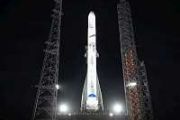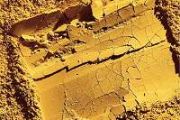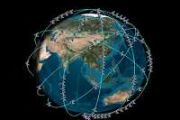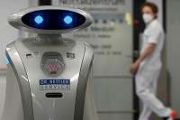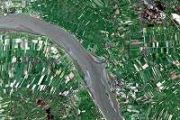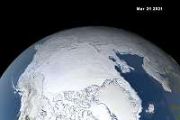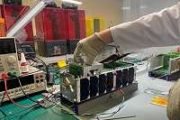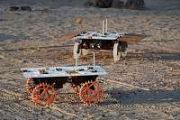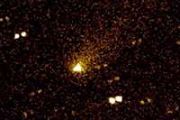
Copernical Team
Searching for life with space dust
 Following enormous collisions, such as asteroid impacts, some amount of material from an impacted world may be ejected into space. This material can travel vast distances and for extremely long periods of time. In theory this material could contain direct or indirect signs of life from the host world, such as fossils of microorganisms. And this material could be detectable by humans in the near
Following enormous collisions, such as asteroid impacts, some amount of material from an impacted world may be ejected into space. This material can travel vast distances and for extremely long periods of time. In theory this material could contain direct or indirect signs of life from the host world, such as fossils of microorganisms. And this material could be detectable by humans in the near Hunting Venus 2.0: Scientists sharpen their sights
 With the first paper compiling all known information about planets like Venus beyond our solar system, scientists are the closest they've ever been to finding an analog of Earth's "twin."
If they succeed in locating one, it could reveal valuable insights into Earth's future, and our risk of developing a runaway greenhouse climate as Venus did.
Scientists who wrote the paper began wit
With the first paper compiling all known information about planets like Venus beyond our solar system, scientists are the closest they've ever been to finding an analog of Earth's "twin."
If they succeed in locating one, it could reveal valuable insights into Earth's future, and our risk of developing a runaway greenhouse climate as Venus did.
Scientists who wrote the paper began wit Waves and a Rock: Sols 3778-3779
 Monday's planned drive positioned Curiosity with a new workspace to investigate. We have left the Marker Band, with Natalie's blog nicely summarizing our campaign there. As a physicist and spectroscopist by training, I find myself looking more at the analytical data, in particular X-ray fluorescence data, acquired on rocks, than the rocks themselves. But there was something about the primary roc
Monday's planned drive positioned Curiosity with a new workspace to investigate. We have left the Marker Band, with Natalie's blog nicely summarizing our campaign there. As a physicist and spectroscopist by training, I find myself looking more at the analytical data, in particular X-ray fluorescence data, acquired on rocks, than the rocks themselves. But there was something about the primary roc NASA seeks student solutions for managing Moon landing dust cloud
 Huntsville AL (SPX) Mar 23, 2023
As NASA and industry partners develop new human landing systems to transport astronauts from lunar orbit to the Moon's surface and back as part of Artemis, the agency is asking university students to investigate solutions to one particularly dusty aspect of landing spacecraft on the lunar surface.
NASA's new Human Lander Challenge invites college students
Huntsville AL (SPX) Mar 23, 2023
As NASA and industry partners develop new human landing systems to transport astronauts from lunar orbit to the Moon's surface and back as part of Artemis, the agency is asking university students to investigate solutions to one particularly dusty aspect of landing spacecraft on the lunar surface.
NASA's new Human Lander Challenge invites college students NRO awards contracts to BlackSky and Planet Labs for hyperspectral capabilities
 The National Reconnaissance Office (NRO) has awarded contracts to BlackSky Technology and Planet Labs Federal for the exploration of commercial hyperspectral image capabilities under the Strategic Commercial Enhancements (SCE) Broad Agency Announcement (BAA) program.
BlackSky Technology, a geospatial intelligence solutions provider, has been selected for a multi-stage SCE BAA framework stu
The National Reconnaissance Office (NRO) has awarded contracts to BlackSky Technology and Planet Labs Federal for the exploration of commercial hyperspectral image capabilities under the Strategic Commercial Enhancements (SCE) Broad Agency Announcement (BAA) program.
BlackSky Technology, a geospatial intelligence solutions provider, has been selected for a multi-stage SCE BAA framework stu Surprisingly simple explanation for the alien comet 'Oumuamua's weird orbit
 In 2017, a mysterious comet dubbed 'Oumuamua fired the imaginations of scientists and the public alike. It was the first known visitor from outside our solar system, it had no bright coma or dust tail, like most comets, and a peculiar shape - something between a cigar and a pancake - and its small size more befitted an asteroid than a comet.
But the fact that it was accelerating away from
In 2017, a mysterious comet dubbed 'Oumuamua fired the imaginations of scientists and the public alike. It was the first known visitor from outside our solar system, it had no bright coma or dust tail, like most comets, and a peculiar shape - something between a cigar and a pancake - and its small size more befitted an asteroid than a comet.
But the fact that it was accelerating away from First results from ESO telescopes on the aftermath of DART's asteroid impact
 Using ESO's Very Large Telescope (VLT), two teams of astronomers have observed the aftermath of the collision between NASA's Double Asteroid Redirection Test (DART) spacecraft and the asteroid Dimorphos. The controlled impact was a test of planetary defence, but also gave astronomers a unique opportunity to learn more about the asteroid's composition from the expelled material.
On 26 Septe
Using ESO's Very Large Telescope (VLT), two teams of astronomers have observed the aftermath of the collision between NASA's Double Asteroid Redirection Test (DART) spacecraft and the asteroid Dimorphos. The controlled impact was a test of planetary defence, but also gave astronomers a unique opportunity to learn more about the asteroid's composition from the expelled material.
On 26 Septe First 3D-printed rocket lifts off but fails to reach orbit
 The world's first 3D-printed rocket launched successfully on Wednesday, marking a step forward for the California company behind the innovative spacecraft, though it failed to reach orbit.
Billed as less costly to produce and fly, the unmanned Terran 1 rocket launched from Cape Canaveral, Florida at 11:25 pm (0325 GMT Thursday) but suffered an "anomaly" during second-stage separation as it
The world's first 3D-printed rocket launched successfully on Wednesday, marking a step forward for the California company behind the innovative spacecraft, though it failed to reach orbit.
Billed as less costly to produce and fly, the unmanned Terran 1 rocket launched from Cape Canaveral, Florida at 11:25 pm (0325 GMT Thursday) but suffered an "anomaly" during second-stage separation as it Virgin Orbit to bring small staff back to work on Thursday
 Virgin Orbit, Richard Branson's satellite launcher service, is expected to return a small staff work on Thursday after suspending operations last week and putting its employees on unpaid furlough.
In a filing with the Securities and Exchange Commission on Tuesday, Virgin Orbit Holdings said it would begin an "incremental resumption of its operations" that would include working on its ne
Virgin Orbit, Richard Branson's satellite launcher service, is expected to return a small staff work on Thursday after suspending operations last week and putting its employees on unpaid furlough.
In a filing with the Securities and Exchange Commission on Tuesday, Virgin Orbit Holdings said it would begin an "incremental resumption of its operations" that would include working on its ne Webb Telescope spots swirling, gritty clouds on remote planet in spectrum data
 Researchers observing with NASA's James Webb Space Telescope have pinpointed silicate cloud features in a distant planet's atmosphere. The atmosphere is constantly rising, mixing, and moving during its 22-hour day, bringing hotter material up and pushing colder material down. The resulting brightness changes are so dramatic that it is the most variable planetary-mass object known to date. The te
Researchers observing with NASA's James Webb Space Telescope have pinpointed silicate cloud features in a distant planet's atmosphere. The atmosphere is constantly rising, mixing, and moving during its 22-hour day, bringing hotter material up and pushing colder material down. The resulting brightness changes are so dramatic that it is the most variable planetary-mass object known to date. The te 










